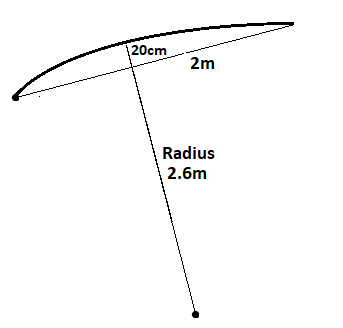How a sail works
The purpose of the sails to make air flow smoothly in a curved fashion.

Example measurements for camber percentage:
Chord = 97, Depth = 17 Ratio= 17%
Chord = 320, Depth = 45 Ratio= 14%
Units of measurement are arbitrary, for example mm on your mobile images
display. Hold your camera device close to the middle of the foot (bottom edge) of
the sail.
We hope that the air, on either side of the sail, remains "attached" in a smooth stream. If the sail is too curved the initial smooth air flow tends to break down into eddies, which is bad.
Causing the air on the front and rear to go in smooth curves creates a centrifugal force on the sail, as the air flow is being pulled towards the centre of curvature like a weight on the end of a string.

For example, if the sail is 5m high and 2m wide at the foot and curved 20cm (10%) deep and affects a total of 5 cubic metres of air at a speed of 10 knots (Force 3-4 Beaufort scale), then the force may be calculated as follows:
Mass of air moving in curve = 5 cubic m x 1.225 kg/cubic.m = 6.125 kg
Speed of air, V = 10 knots = 10 x 0.5144 m/s = 5.144 m/s
The radius of the curved airflow may be calculated using this formula:
W = width of sail (2m) C = camber depth (0.2m)
Radius of curved airflow R = C / 2 + (W x W) / (8 x C) = 0.2 / 2 + (2 x 2) / (8 x .2) = 2.6 m
Centrifugal force = M x V x V / R N (N means units of Newton)
This calculator below works out what centrifugal force applies to the sail and how this may be resolved into in-line driving force and sideways capsizing force.
Default values assume 10% camber and close hauled with sail 10 deg off the centreline.
The thickness of the air affected is assumed to be half the width of the sail along the foot, at the boom.
If you play with this a bit you will learn that the total force on the sail may be increased by increasing the camber from 10% to 12 %, or the total force decreased by reducing the camber from 10% to 5%.
Also, and rather important, that the more the sail is let out the greater the component of total sail force is in line with the boat. Don't keep the boom in too tight !
How to trim the Sail
If your helm is trying to steer a straight course and not aiming for an upwind or downwind objective, then you need to actively trim the sails for maximum forwards force. For trimming the sail, let it out as far as you can without allowing the smooth curved airflows to break down. Watch out for no rippling of the sail just back from the leading edge (luff wire on the jib or the mast on a mainsail) and smooth trailing of the tell-tails all down the leech (back edge) of the sail(s). If you have see-through windows in the sails near the luff (front edge) try to keep the tell-tails either side flowing smoothly.
The camber may be adjusted up to about 12 %, when the smooth airflows may start to break down. You may safely decrease the camber to reduce both driving and capsizing forces if you can't reef the sail or use smaller sail.
If your helm is aiming for an upwind or downwind objective then adjust and initially set the sails either for close-hauled or downwind sailing and the leave the helm to actively steer to keep the air flows smooth.
In the calculation below, note that the angle of the sail to the centre line of the boat varies as you go higher up the mast, due to twist in the sail. Use an angle about 1/3 of the way up.
Feedback welcome, click to email me eric@satsig.net to say what you would like to add below...
Do the results even approximate to reality ?
|
Page created 15 June 2018, amended 28 April 2025 ECJ (c) 2018 Copyright. All rights reserved. |